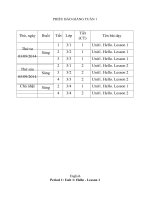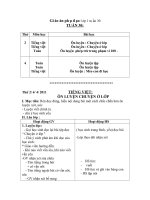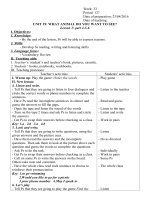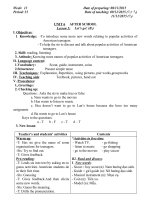GIAO AN TIENG ANH LOP 1 TUAN 30
Bạn đang xem bản rút gọn của tài liệu. Xem và tải ngay bản đầy đủ của tài liệu tại đây (77.21 KB, 6 trang )
<span class='text_page_counter'>(1)</span><div class='page_container' data-page=1>
<b>i-Learn Smart Start 1</b>
<b>Week: Date of teaching:...</b>
<b>Period: 1 </b>
<b>UNIT 9: TOYS</b>
<b>Lesson 3</b>
<b>I. Objectives:</b>
By the end of this lesson, students will be able to ask and answer about numbers of
objects.
<b>II. Teaching aids:</b>
<b>Teacher’s aids: student book and teacher’s book, class CDs, flashcards, IWB software, </b>
projector/interactive whiteboard/TV.
<b>Students’ aids: Student books, notebooks, workbooks.</b>
<b>III. Languages focus:</b>
<b>Vocabulary: seven, eight, nine, ten</b>
<b>Structure :</b>
(Ten) (teddy bears)
<b>IV. Procedures:</b>
<b>Time</b> <b>Steps/Activities</b> <b>Organization</b>
5’ <b>Warm-up</b>
<i><b>Option 1: </b></i>
<i><b>Song: sing the alphabet song</b></i>
<b>Whisper</b>
<b>-</b> Arrange children into rows of at least six.
<b>-</b> Secretly show a flashcard to the first child in each group. This
child whispers the word to the child next to him/her.
<b>-</b> Children continue whispering the word to the child next to them
until the word reaches the final child.
<i><b>-</b></i> The final child says the word out loud, and the first child holds
up the flashcard to see whether the word is correct.
<i><b>Option 2: </b></i>
<i><b>Song: sing the alphabet song</b></i>
<b>Musical cards </b>
<b>-</b> Play some lively music.
<b>-</b> Hand out the flashcards from the previous lesson.
Teacher –
whole class/
groupwork/
individuals
</div>
<span class='text_page_counter'>(2)</span><div class='page_container' data-page=2>
<b>-</b> Children pass the flashcards around all the rows of seats while the
music is playing.
<b>-</b> Stop the music suddenly. Ask the children who are holding the
flashcards to stand up and say the word. E.g. “one.”
<i><b>-</b></i> Play the music and continue in the same way.
25’ <b>New lesson</b>
<b>A- Listen and point. Repeat.</b>
CD2- Track 48
- Arrange the flashcards on the board, play audio and point to
each flashcard.
- Play audio again and have students point to the pictures in
their books.
- Play audio again and have students listen and repeat.
- Play "Guess."
- Arrange the flashcards on the board and write a number under
each card.
- Have students look at the flashcards for the count of ten. Turn
the flashcards over to face the board when the students are
not looking. Call out a number and have students take turns to
guess the face-down card. Turn the card over after each guess.
<b>B- 1.Listen and point.</b>
CD2- Track 49
- Have students call out the things they can see.
- Have them count the cars, balls and teddy bears.
- Have students listen and follow.
- Play audio and demonstrate pointing.
- Play audio. Have students listen and point.
<b>2. Listen and repeat.</b>
CD2- Track 50
- Have students look at the useful language box.
- Play audio. Have students listen to the useful language.
- Have students practice the useful language.
<b>C- Point and say.</b>
- Have students look at the pictures and identify the things they
see.
- Divide the class into pairs.
- Have Student A point to the pictures and Student B say, e.g.
Teacher-whole
class/
groupwork/
individuals
Teacher-whole
class/
individuals
Teacher-whole class
</div>
<span class='text_page_counter'>(3)</span><div class='page_container' data-page=3>
"seven books."
- Swap roles and repeat.
- Have some pairs demonstrate the activity in front of the class.
<b>Optional activities:</b>
<i><b>Option 1: </b></i><b>Count the objects</b>
- Have students take out their school objects and have them
work in pairs. Student A points to the objects he/she has and
say the quantity.
- Swap roles and continue.
<i><b>Option 2: </b></i><b>Run and draw.</b>
<b>-</b> Have students work in four teams.
<b>-</b> Stick four blank sheets on the board.
<b>-</b> Say “ Draw four books.” Have one student of each team run to
the board to draw what the teacher said.
<i><b>-</b></i> Continue the game in the same way.
<b>-</b> The winner is the team who has the most correct pictures.
Teacher-whole class/
pair work
Teacher-whole class/
teamwork
5’
<b>Wrap-up</b>
<i><b>Option 1: </b></i><b>Pass the envelope</b>
- Divide the class into groups.
- Give each group an envelope with the word cards inside. E.g. “ five
books, ten cars….”
- Play a song as background music. Children pass the envelope to a
classmate as the music plays.
- Stop the music randomly. The student holding the envelope
opens it and takes out one card then read it aloud.
- Continue the game until there are no more cards left in the
envelope.
<i><b>Option 2: </b></i><b>Find the objects</b>
- Hide some school things and toys at many places in the
classroom.
- Have students go around, find and count the objects.
Teacher –
whole class/
groupwork/
individuals
Teacher –
whole class/
teamwork
</div>
<span class='text_page_counter'>(4)</span><div class='page_container' data-page=4>
<b>Week: Date of teaching:...</b>
<b>Period: 2 </b>
<b>UNIT 9: TOYS</b>
<b>Lesson 3</b>
<b>I. Objectives:</b>
By the end of this lesson, students will be able to ask and answer about numbers of
objects.
<b>II. Teaching aids:</b>
<b>Teacher’s aids: student book and teacher’s book, class CDs, flashcards, IWB software, </b>
projector/interactive whiteboard/TV.
<b>Students’ aids: Student books, notebooks, workbooks.</b>
<b>III. Languages focus:</b>
<b>Vocabulary: seven, eight, nine, ten </b>
<b>Structures : </b>
(Ten) (teddy bears)
How many (cars)?
(Seven) (cars).
<b>IV. Procedures:</b>
<b>Time</b> <b>Steps/Activities</b> <b>Organization</b>
5’ <b>Warm-up</b>
<i><b>Option 1: </b></i><b>Flyswatter</b>
Play flashcards ( or write “ seven books, nine teddy bears, ten
cards, eight balls) on the board.
Divide the class into four teams. Have one student from each
team come to the board holding a flyswatter.
Read content of one flashcard aloud, e.g. “seven books” . Have
students race to the board and hit the words with the
flyswatter. The winner is the one who hits the correct words
first.
Play until everyone in the class has had at least one turn.
<i><b>Option 2</b><b>:</b><b> </b></i><b> Feely Bag</b>
Put some pictures in a bag.
Have children sit in a circle.
Play some music and ask children to pass the bag from one
Teacher –
whole class/
teamwork
</div>
<span class='text_page_counter'>(5)</span><div class='page_container' data-page=5>
child to the next around the circle.
Stop the music suddenly. The child who has the bag when the
music stops feels a picture in the bag and says “ seven books.”
Then the child pulls the picture out of the bag to see if he/she
was correct.
Play the music and continue in this way until several children have
had a turn.
individuals
25’
<b>New lesson</b>
<b> D-1. Listen to the story.</b>
CD2- Track 50
- Have students call out the things they can see.
- Introduce the situation: “ Vinh and Bobby are playing. Vinh
asks: How many cars? And Bobby answers: Seven cars.”
- Play audio and have students listen and read.
<b>2. Listen and repeat.</b>
- Have students look at the useful language box.
- Play audio. Have students listen to the useful language.
- Have students work in pairs, practicing the useful language.
<i><b>Optional activity 1: </b></i><b>Role-play</b>
Have students work in pairs and act out the story.
<b>E- Play” Count the objects”</b>
- Have students look at the pictures and call out the things they
see.
- Divide the class into pairs.
- Have Student A ask and Student B answer.
- Swap roles and repeat.
- Have some pairs demonstrate the activity in front of the class.
<i><b>Optional activity 2: </b></i>
<b>-</b> Have students take out their school things, count the things
they have and work in pairs. Student A asks and student B
answers the question.
<b>-</b> Swap roles and continue.
Teacher –
whole class/
individuals
Teacher-
whole class/
pair work
</div>
<span class='text_page_counter'>(6)</span><div class='page_container' data-page=6>
5’
<b>Wrap-up</b>
<i><b>Option 1: </b></i><b>Unscramble the sentence.</b>
-Have students work in groups of four.
-Give each groups some flash cards, each card has a word on it.
-Set up a limit time.
-Have students arrange words to make sentences. There are four
sentences for each group.
-Have students in each group give their ideas about the tasks.
-Teacher gives correct answers.
<i><b>Option 2: </b></i><b>Running dictation</b>
Stick some pictures (one bag, nine teddy bears, ten cars, eight
<i>balls) on the walls in the class.</i>
Have students work in pairs. One runs and find the pictures
around him/ her, then turn back to his pair and tell what he/
she has seen. E. g One bag. His/ Her friend writes down the
word he/ she has heard.
Teacher –
whole class/
teamwork
Teacher –
whole class/
pair work
balls
many How ?
. cars
Nine
How
many
cars
?
.
Six
</div>
<!--links-->









